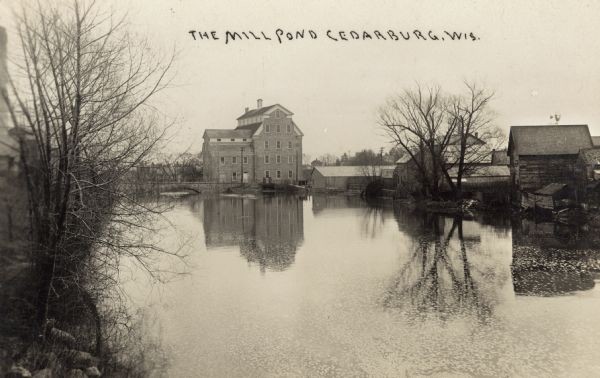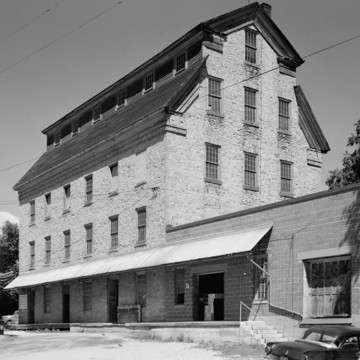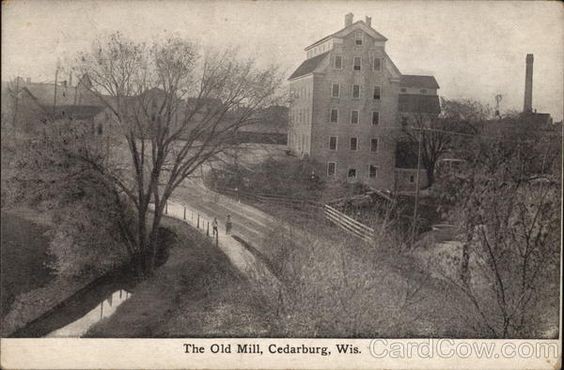Cedarburg Mill
Introduction
Text-to-speech Audio
On the second stop on the tour is the Cedarburg Mill. This mill is special to Cedarburg, not just for the economic value it brought to the town. But also for its historic nature. This mill is considered one of the most historic mills and tallest mill in the Midwest.
Images
The Cedarburg Mill In The 1950s

The Mill In The 1960s

The Cedarburg Mill In The 19th Century. The road in that period is today Portland Road

Backstory and Context
Text-to-speech Audio
In 1844, thirteen years before the establishment of the Hilgen-Schroeder Mill Store. Frederick Hilgen and William Schroeder acquired 36 acres from Ludwig Groth. Both Groth and Schroeder were also German immigrants seeking a better life in the United States and, like Hilgen, were land speculators. By 1845, a massive market swung open for cutdown limber and wheat and other farmers' goods. Both Hilgen and Schroeder, at this time, were chopping down trees to make a path that would give accessible to what was then the Green Bay Road that led to Milwaukee. They had also chosen a route where those settling in Cedarburg find their homes and businesses in the town for the first time. At this time, Schroder and Hilgen set out to build a mill to meet farmers' goods' needs and the lumber industry.
After acquiring the land from Groth, Hilgen and Schroeder made ready to build their initial grist mill. With the help of Burchard Weber, the mill was built and established in 1855. Located along Cedar Creek, the building itself would be built at $22,000 to replace and build the mill with a high stone building. Unfortunately, since Cedar Creek is close to the mill, the dam was struck heavily by water and would be fixed in 1855. When Weber built the structure, it was a 6-story structure containing an outlying limestone dug from the creek. The floors themselves, especially the first floor and three following floors, were held by hand chipped white oak. These white oak beams were 40 feet long with 16 by 16 squares. Twenty of these white oak beams remain in the building. According to one Cedarburg legend, workers briefly redirected the stream to the east. This was done so the stones would be cut and transported through a tramway from the creek by one man aggressively pushing and another man extracting them.
Since there was no modern construction equipment in the nineteenth century, the building would significantly grow to a bigger size. So, as a result, an earth approach would be built to transport the building materials to the structure's upper levels. Farm animals such as donkeys and oxen were used to help pull the heavy stones and large oak beams. These beams were to guise the upper five stories of the building. The incline was reported back then to expand to the Washington House. In the early 1800s, mills in their popularity coincided with their roofs. The Cedarburg Mill, its monitor roof was a popular feature, not just in the Cedarburg Mill but in mills in the Eastern United States in the 1800s. The reason why? Because monitor roofs provide more light and ventilation than other roof features. If you look very closely at the mill's roof, the hand-cut limestone blocks can be seen mixed in with the other classes of bricks on the roof. As soon as the mill was lengthened, the Hilgen-Schroeder Mill Store, which operated flour and feed, was established across the street where it could do business with the mill. Hilgen gave his share of the mill to Schroeder and another man, Joseph Trottman, in 1865. Then sold it to the Grundke's son and daughter-in-law of Fred Hilgen in 1882. The mill, still running on water power, was sold to the Cedarburg Supply Company in 1930. After trying to invest in a new water wheel, it converted to electrical power. The Cedarburg Mill is one of the most historical and beautiful mills in the Midwest and was registered in 1961 to the National Register Of Historic Places as a historic building.
Cite This Entry
Brueggemann, Marc. "Cedarburg Mill." Clio: Your Guide to History. April 21, 2022. Accessed April 17, 2025. https://theclio.com/tour/2217/2
Sources
Cedarburg History: Legend And Lore. Edition 1st. Cedarburg, Wisconsin. Library Of Congress, 1976.
The Cedarburg Mill.
Perrin, Richard W.E.. Historic Wisconsin Architecture. Madison, Wisconsin. The Wisconsin Chapter Of The American Institute Of Architects , 1960. 18.
Zimmermann, H. Russell. The Heritage Guidebook: Landmarks And Historical Sites In Southeastern Wisconsin. Milwaukee, Wisconsin. Heritage Banks, 1976. 203.
A Walk Through Yesterday: In Cedarburg Wisconsin. 2005.
Zimmermann, H. Russell. The Heritage Guidebook: Landmarks And Historical Sites In Southeastern Wisconsin/Highlights Of Historic Cedarburg. Milwaukee, Wisconsin. Heritage Banks, 1976.
Historic American Buildings Survey, Creator, Frederick Higen, William Schroeder, Henry C Edwards,
Cedarburg Mill, Ozaukee County Wisconsin. Accessed April 8th 2022. https://www.co.ozaukee.wi.us/1011/Cedarburg-Mill.
Wisconsin Historical Society, Montgomery-Walter Photograph Company, The Mill Pound, Cedarburg, Wisconsin, 122090. Viewed online at (https://www.wisconsinhistory.org/Records/Image/IM122090).
https://www.wisconsinhistory.org/Records/Image/IM122090
https://sah-archipedia.org/buildings/WI-01-OZ2
https://www.cardcow.com/553745/cedarburg-wisconsin-old-mill/

